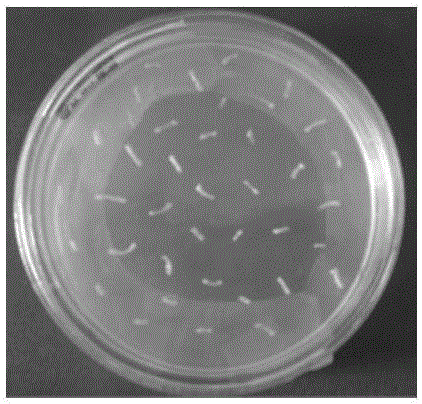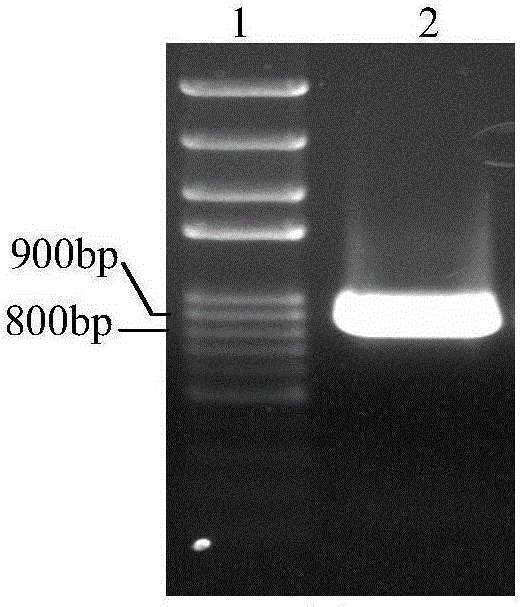Eucalyptus TPS gene, RNA interference vector and application thereof
A RNA interference and gene technology, applied in the field of RNA interference carrier, can solve the problems of reducing the allelopathic effect of eucalyptus, and achieve the effect of overcoming the long cycle, reducing the content of allelochemical substances, and high-efficiency allelopathic effect
- Summary
- Abstract
- Description
- Claims
- Application Information
AI Technical Summary
Problems solved by technology
Method used
Image
Examples
Embodiment 1
[0069] Embodiment 1, the acquisition of full-length cDNA of Eucalyptus TPS gene
[0070] Step 1. Obtaining a fragment of the conserved region of the TPS gene of Eucalyptus: using the conserved functional region of the TPS gene of various plants as a template, a partial cDNA fragment of the TPS gene was obtained by RT-PCR.
[0071] (1) Comparative analysis of the TPS genes of various plants such as tobacco (GenBank accession No.L04680), fir (GenBank accession No.U87910), sage, mint (GenBank accession No.L13459), and the conserved regions as Template, designed primer pair TPS-F1 and TPS-R1 as described in SEQ ID NO1 and SEQ ID NO2; (2) extract Eucalyptus leaf total RNA, utilize the reverse transcriptase RevertAid M- that cDNA reverse transcription kit provides MuLV Reverse Transcriptase and Oligo dT18 primers were reverse-transcribed into total cDNA; (3) using the transcribed cDNA as a template, and using SEQ ID NO1 and SEQ ID NO2 as primers for RT-PCR amplification, the target ...
Embodiment 2
[0081] Embodiment 2, reduce the construction of eucalyptus allelopathy RNA interference carrier
[0082] Step 1, design the RNA interference fragment primer of Eucalyptus TPS gene
[0083] According to the TPS gene sequence and the analysis of multiple cloning sites on the pKANNIBAL vector, Xho I and Kpn I can be used to connect the forward fragment of the target gene to the vector; and Hind III and Xba I can be used to connect the reverse fragment to the vector. Therefore, the following primers were designed:
[0084] TPS-RNAi-F1:5'-CATG CTCGAG TGCCTTGACGGACTTCAA-3' (the underlined part is the Xho I restriction site)
[0085] TPS-RNAi-R1:5'-CTGA GGTACC ATGCTTGGGCTTGCTAAGA-3' (the underlined part is the Kpn I restriction site)
[0086] TPS-RNAi-F2:5'-CATG AAGCTT ATGCTTGGGCTTGCTAAGA-3' (the underlined part is the Hind III restriction site)
[0087] TPS-RNAi-R2:5'-CTGA TCTAGA TGCCTTGACGGACTTCAACGT-3' (the underlined part is the Xba I restriction site)
[0088] Step 2...
Embodiment 3
[0097] Example 3, RNA interference vector electroporation transformation of Agrobacterium tumefaciens EHA105
[0098] Since the heat shock transformation efficiency of the recombinant plasmid pART27-TPS-RNAi into Agrobacterium EHA105 is low, the present invention adopts the electric shock transformation method to obtain the recombinant Agrobacterium containing the target gene. Specific steps are as follows:
[0099] Step 1. Mix 1 μg of plasmid pART27-TPS-RNAi with 150 μl of Agrobacterium EHA105 competent cells, add them into a sterilized electric shock cup, and perform electric shock transformation at a voltage of 2.5KV.
[0100] Step 2, then add 800 μl of liquid medium to rinse the electric shock cup and transfer to a 1.5ml centrifuge tube, culture at 28°C, 220rpm for 2h.
[0101] Step 3. Spread the culture solution on a YEB solid plate (kanamycin 50 μg / ml; rifampicin 50 μg / ml), and culture at 28° C. for about 18 hours.
[0102] Step 4. Pick a single colony and put it in 5m...
PUM
 Login to View More
Login to View More Abstract
Description
Claims
Application Information
 Login to View More
Login to View More - R&D
- Intellectual Property
- Life Sciences
- Materials
- Tech Scout
- Unparalleled Data Quality
- Higher Quality Content
- 60% Fewer Hallucinations
Browse by: Latest US Patents, China's latest patents, Technical Efficacy Thesaurus, Application Domain, Technology Topic, Popular Technical Reports.
© 2025 PatSnap. All rights reserved.Legal|Privacy policy|Modern Slavery Act Transparency Statement|Sitemap|About US| Contact US: help@patsnap.com



